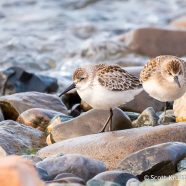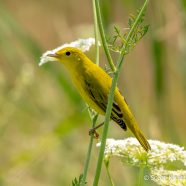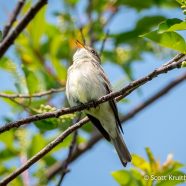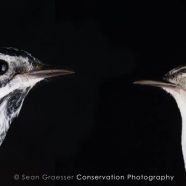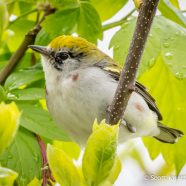Western Sandpiper (Calidris mauri)
Fall shorebirding can be very rewarding in a number of diverse habitats including farm fields, parking lots with pools of water, muddy pastures, grasslands, beaches, and rocky shorelines. Whether they are foraging, preening, or roosting there are always good chances to examine shorebirds for prolonged periods. That does not mean the task of identifying them will be easy! For every readily identifiable bird like the American Oystercatcher there seem to be a few difficult to discern species. The juvenile Western Sandpiper (Calidris mauri), as seen below and photographed in late August, can be...
Read MoreYellow Warbler on Queen Anne’s Lace
It turns out there are a lot of fans of Queen Anne’s Lace (Daucus carota)! This Yellow Warbler (Setophaga petechia), photographed yesterday, is among them. The autumn migration continues (what?!) with birds heading south for the winter, and Yellow Warblers enjoy stopping in grasslands and shrublands to feed on the many insects they contain. The faster you can start your journey south the more food you will find along the way all while making a more relaxed trip. Suffice it to say this bird will not be facing the prospect of ice and snow as some warblers still migrating in October...
Read MoreEastern Wood-Pewee
I recently mentioned that we still have flycatchers coming into the region as spring migration wraps up, and even into early June you may find individuals at migratory stopover sites. One such bird was this Eastern Wood-Pewee (Contopus viren), and he provided far better looks here than most do in the depths of the dark forest or higher up in the canopy. Finding him was easy thanks to that “peeeeaaaweeee” call, and he is belting it out in the second photo. Identifying flycatchers by voice makes life so much easier, especially when you cannot always rely on habitat thanks to...
Read MoreBlack-and-white Warblers
Black-and-white Warblers (Mniotilta varia) were the most common migrant this spring in Connecticut for RTPI Affiliate Sean Graesser, and he even thinks that breeding individuals may stick around at Audubon Greenwich. This is male on the left and female on the right. Only now is their migration finally winding down after a tremendous season for the species.
Read MoreChestnut-sided Warbler
The Chestnut-sided Warbler (Setophaga pensylvanica) is one of the most unique of our warblers in terms of appearance, though this bird is not quite showing all of that chestnut, black or bold yellow yet. It is likely a first spring male that was still coming into his plumage in early May. He was very friendly and cooperative for both photos and prolonged binocular views, allowing a group of birders to enjoy him posing while foraging without the use of any pishing or song playbacks. In my experience the best tactic for spring migratory birding is often just to move slowly, be quiet and...
Read More



